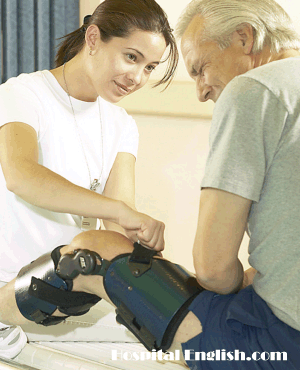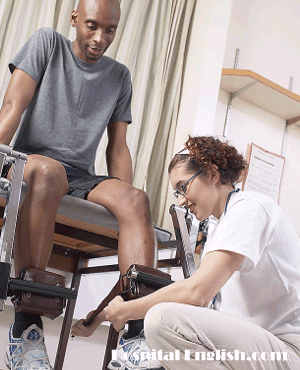Healthcare Professional Articles: Vocabulary, listening, and reading exercises for students to learn and practice English.
Physical Therapy
Vocabulary:
asthma
cardio-pulmonary
conditions
COPD
cystic fibrosis
devices
diagnosis
disability
disease
integumentary
motor function
musculoskeletal
physical therapist
physical therapy
physiotherapist
physiotherapy
reduction
rehabilitation
scar
technique
therapeutic
treatment
wounds

Listen to the Physical Therapist article:
Listen and try to answer the discussion questions. You can also listen and read along with the script below.
Article 1: The Physical Therapy ![]()
Listen to the audio file for the Physical Therapyand then you may advance to the test questions. Listen as many times as you need to answer the questions. (You can read the full articles below.)
Follow-up: After completing the test exercises, try the speaking activity with the conversation questions.
For self study: Verify you understand the key words for the articles. Then try to answer the following conversation questions, speaking out loud.
Conversation Questions:
- What responsibilities does the physical therapist have?
- What conditions are treated by the physical therapy department?
- What are some types of therapies used?
- What types of medical devices do physical therapist prescribe?
Reading: read the article and then answer the questions.
The physical therapy department is much broader than just rehabilitation. Physical therapy treatment is provided under the care of a physical therapist, also known as a physiotherapist. The physical therapist is responsible for diagnosis, assessment and treatment of disease or disability. The conditions physical therapists manage are musculoskeletal, cardio-pulmonary, integumentary and neurological conditions. Rehabilitation spans all four of these categories. Treatment may involve patient education, physiotherapeutic techniques, and assisting devices.
Musculoskeletal physiotherapy uses a variety of techniques to treat heart and lung diseases such as asthma, cystic fibrosis and chronic obstructive pulmonary disease (COPD.)
Integumentary physiotherapy deals primarily with treatment of the skin. This may include care of wounds, bandages, and scar reduction.
Neurological physiotherapy use exercise to help improve motor function.
Outside of the hospital, physical therapists work in home daycare centers, schools, clinics, nursing care centers, rehabilitation centers and for athletic clubs.

End User License Agreement: You are free to download any resource from this site as an end user and MES-English.com grants you an End User License with the following restrictions: You may not redistribute, copy, modify, transfer, transmit, repackage, charge for or sell any of the materials from this site. You may use photocopies or printouts for distribution to your students. MES reserves the right to terminate or make changes to this agreement for any reason and without notice.
Copyright © 2006 - 2025 Hospital English | restrictions | privacy | about | contact

